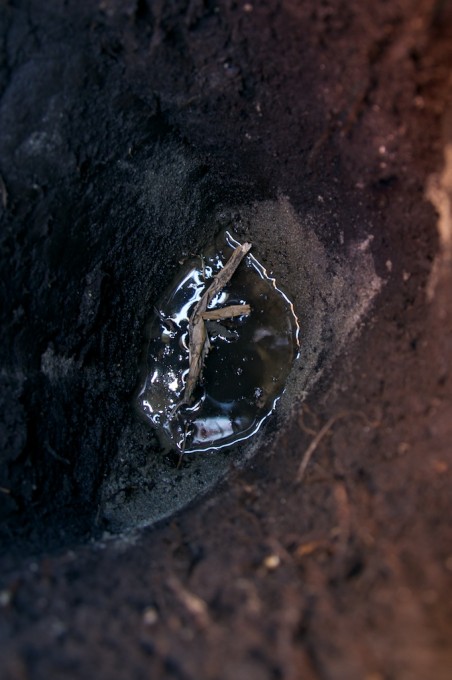

For the time being, NASA’s Soil Moisture Active Passive (SMAP) satellite is waiting to rocket into orbit.
Media packed up their cameras after the first scheduled launch from Vandenberg Air Force Base in California was scrubbed on January 29, 2015 (above) due to upper level winds. The second targeted launch window on January 30 was delayed to January 31, “pending completion of minor repairs to the United Launch Alliance Delta II launch vehicle,” according to a NASA press statement.
The Soil Moisture Active Passive (SMAP) mission is one step closer to launch. On January 28, the mobile service tower (top) rolled back to reveal the Delta II rocket (second image). Liftoff of the Delta II rocket and its satellite cargo is targeted for launch from Vandenberg’s Space Launch Complex 2 at 6:20 a.m. PST on Thursday, January 29.
NASA administrator Charles Bolden attended the rollback event, where he spoke to a group gathered to watch the reveal. “What will SMAP measure?” asked a second-grade student (above).
Bolden was not the only one answering that question on the day before launch. SMAP scientists Dara Entekhabi, Randy Koster, Wade Crow, and Susan Moran (above, from left to right) started the day explaining the mission’s science to a gathering of social media mavens. So, what will SMAP measure? Visit the mission page to find out.
SMAP is ready to go!
The Soil Moisture Active Passive (SMAP) mission, which will map the water content of soils worldwide, passed its “launch readiness review” on January 27. There is also a favorable weather forecast for a launch on January 29. So the SMAP team is ready.
“It has reached the point where it’s an amazing energy rush right now,” said Christine Bonniksen, SMAP program executive. “It’s kind of like when you’re listening to Beethoven’s 6th symphony, when you’re getting to the big crescendo, and everybody can feel it coming. It’s amazing to watch all these folks buckle down.”
Bonniksen spoke at a press briefing marking two days before the scheduled launch. She highlighted the role of SMAP among other missions studying our planet: Once it’s in orbit and operational, SMAP will join 19 other NASA satellites and sensors with an eye on Earth. The start of the SMAP mission also will complete a series of five Earth science launches in the past year.
“We’re really looking forward to the synergism from all these instruments,” she said.
Soil moisture factors into three major cycles of Earth’s environment — water, energy, and carbon — said Dara Entekhabi, SMAP science team lead. The three cycles work together like gears in a clock, linked together by soil moisture and the freezing and thawing of the ground. With SMAP, scientists will improve models of climate and weather forecasting, and better understand the workings of the planet.
“SMAP will peer into the metabolism of Earth’s environment,” Entekhabi said.
 Sab Kim
Sab Kim
Jet Propulsion Laboratory
Updates on the vegetation conditions are provided here, monitored by the crop structure team. There were localized thunderstorms on July 15th, which gave 8 mm rainfall according to the local weather data. I happened to be in the field(!) and believe the campaign fields received much more. Some fields outside the low-altitude flight lines were not visited by the structure team. The conditions of these fields were instead monitored by the vegetation teams.
All the crops grew enough to start to make grains, and the percent ground covered by the vegetation was 80% to 100%, according to observations made between July 7th and 17th. The corn plants grew to 225cm high and will not grow much further even after the rainfall on 15th. Instead tassels and ears are developing, but no cobs yet.
For more information, visit the SMAP Blogs From the Field site.
 Steven Chan
Steven Chan
Jet Propulsion Laboratory
As an avid photographer, I totally agree with what Diane Arbus said, “I really believe there are things that nobody would see if I didn’t photograph them.” So here in this blog I’m taking a more photojournalistic approach. Enjoy!
My work in SMAPVEX12 primarily consisted of two tasks: Vegetation sampling in crop fields and soil moisture sampling in forests. The two tasks alternated according to PALS flight schedule and weather conditions. Because I arrived in July, my observations were all about the later phase of the campaign.
Our cropland vegetation sampling involved measurements of optical parameters (e.g., LAI and NDVI) and allometric parameters (e.g., height and diameter). On a typical day we visited up to six fields to collect data and actual plant samples.

Wheat had matured quite a bit since the beginning of the campaign. Here Brian, Hida (U. Guelph), and Tracy were carrying plant samples for further analysis at the ROC.

Tracy (U. Guelph) and Brian (U. Manitoba) were making LAI and NDVI measurements, respectively, in a soybean field.

Example of a typical soil profile: Litter (not shown), then organic layer (brownish orange layer), then soil (gray-colored layer), and then groundwater.
For more information, visit the SMAP Blogs From the Field site.